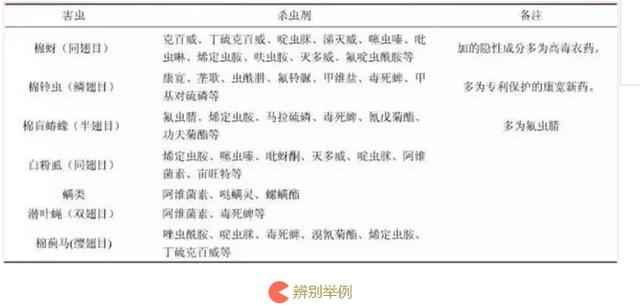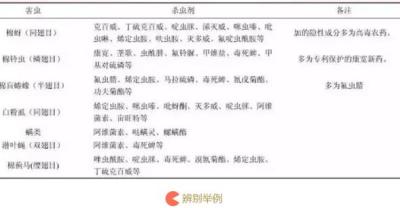Do you know the hidden ingredients of pesticides? How to tell what kind of pesticide it is?
Generally speaking, "special effects" medicine samples will have distinct characteristics, such as what insects to kill, what diseases to prevent, and what weeds to remove. For the sample requiring analysis, we should first provide the price, that is, the price per ton, so that we can give a preliminary positioning of the position of the sample in the current pesticide market: whether it is a new drug and what kind of pesticide it may be.
Provide control object, is it for insecticidal, herbicidal or bactericidal? What kind of pest, what kind of bacteria or which recommendation is insecticidal? In this way, the range of pesticides is initially judged according to the type of control of disease and caterpillar fungus. For example, cotton aphid, you can consider those aphid insecticides. For example, to kill cotton bollworm (Lepidoptera, Noctuidae), we should consider those insecticides that kill Lepidoptera, such as chlorobenzamide and so on.
The efficacy characteristics of pesticides. Different types of pesticides have different symptoms of poisoning. First of all, according to the symptoms of pest poisoning, the type of pesticide can be preliminarily judged. Such as pest poisoning, curling, spitting, spasm, the sample may be organophosphorus pesticides. Secondly, according to the insecticidal speed, it is also an important basis to help identify the types of insecticides. Such as insecticides, carbamates, pyrethroids, organophosphorus insecticidal speed is faster, while chitin inhibitors, slow efficacy, need 3 days to see the effect. The second is the appearance and smell of pesticides. For example, organophosphorus has the smell of garlic, stench or sulfur. Pyrethroids insecticides will be irritating to human eyes and skin during prevention and treatment. The symptoms of new nicotine insecticides such as acetamiprid and avermectin on armyworm poisoning are anaesthesia, false death, no atrophy, no spitting water, and active touch. The above characteristics can be used as a reference for the qualitative determination of pesticides.
Combined with simple bioassay, supplemented by sample characterization, if insecticides are insecticides, we can simply use armyworm, aphids and red spiders to determine the preliminary efficacy, and roughly judge the control direction of the sample according to the efficacy, and then carry on the instrument analysis and qualitative analysis. In particular, it should be noted that the stomach toxicity test results of armyworm should be maintained for 4 days, and then the mortality rate should be calculated to prevent chitin pesticides from being missed.
Attached table: reference for the analysis of some pesticides

Discrimination example
1. The "special effect" EC of cotton aphid. This sample is a product sent by a large cotton grower, and it is a three-no product. It is also told that the variety is fast in killing insects. According to the control experience of cotton aphid, it is considered that high toxic insecticides may be added. Determined by HPLC, it did contain carbofuran.
2. Analysis of herbicides in cotton field. Three bags of samples, one large bag and two small bags. Among them, the large bag was marked as quizalofop, and the other two small bags were marked as synergist to control Gramineae and broad-leaved weeds. Quizalofop is only effective on Gramineae weeds, but not on broadleaf weeds and has no effect on cotton growth. The characteristics of killing broad-leaf weeds should be related to sulfonylurea herbicides, which is a sulfonylurea herbicide by HPLC analysis, and another small bag is a penetrating agent.
3. Insecticide control of leaf miner. The label is avermectin. According to experience: avermectin itself is very effective against leaf miners and should also be organophosphorus insecticides. One kind of organophosphorus insecticide was analyzed by HPLC. Considering that avermectin decomposes when most organophosphorus insecticides are mixed with avermectin, the authors do not recommend the mixture of avermectin and avermectin. In fact, it has been proved that avermectin has been decomposed and the content of avermectin can not reach the standard.
4. The specific medicine for killing cotton bollworm is "free for two weeks". It is known that chlorobenzamide is effective against Helicoverpa armigera and is consistent with the quoted price. It was proved to be chlorobenzamide by HPLC analysis, but its content was very low.
5. Long-acting medicine for the prevention and treatment of cotton bugs. The active ingredient of the label is BT, which indicates that it should be produced with a set of certificates, and BT does not treat bug bugs at all. The actual analysis is a high content of fipronil.
6. Spray three anti-omethoate EC. It shows that it can control wheat aphid, powdery mildew and dried leaves at the same time. Gas chromatography analysis shows that the decomposition of omethoate can be reduced when a large diameter capillary column is used. The results showed that the decomposed content of omethoate was very low, and there was little fungicide fenning left.
7. Control whitefly EC. The cotton planting base of Hejian Guoxin Agricultural Research Association sent it to say that it is effective to control whitefly. By HPLC analysis, the effective components were acetamiprid, enantiomide and avermectin. Operator: Wei Yubo MX008
- Prev

Is white frost on grape skin a pesticide? Officials avoid rumors: it's not pesticides, it's fruit fans.
Li Yunhui, a reporter from Jiangxi, China, reported that August and September is the season for concentrated listing of grapes. Recently, it has spread in the circle of friends of many citizens.
- Next

It is not good to farm and hit pesticides, and it is not good not to hit pesticides. What should we do?
A few days ago, I went back to my hometown and went for a walk by the river outside the town. As a result, I found a pile of empty agricultural medicine bottles and bags by the field. Specially looked it up on the Internet, Pi.
Related
- Fuxing push coffee new agricultural production and marketing class: lack of small-scale processing plants
- Jujube rice field leisure farm deep ploughing Yilan for five years to create a space for organic food and play
- Nongyu Farm-A trial of organic papaya for brave women with advanced technology
- Four points for attention in the prevention and control of diseases and insect pests of edible fungi
- How to add nutrient solution to Edible Fungi
- Is there any good way to control edible fungus mites?
- Open Inoculation Technology of Edible Fungi
- Is there any clever way to use fertilizer for edible fungus in winter?
- What agents are used to kill the pathogens of edible fungi in the mushroom shed?
- Rapid drying of Edible Fungi

